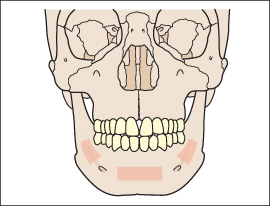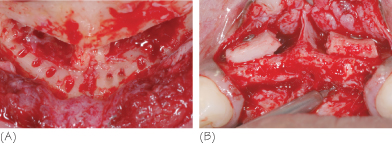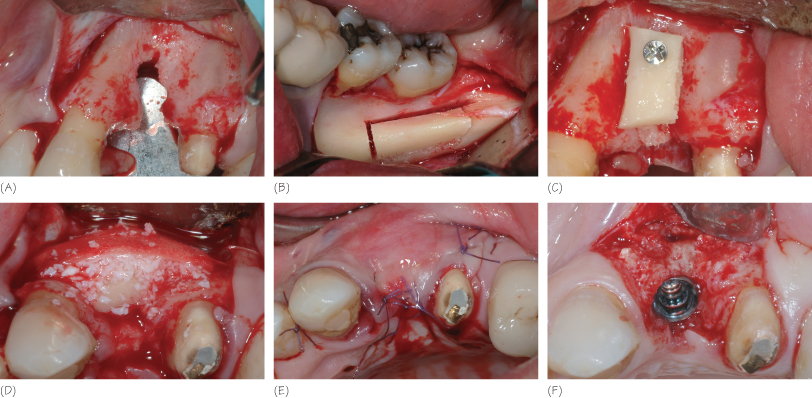39
Bone augmentation: block bone grafts
Rationale
Bone grafts taken from patient themselves are the “gold standard” in bone reconstruction. Autogenous bone grafts can be harvested from intraoral sites (Fig. 39.1) for small defects, or from extraoral sites (calvaria, iliac crest, tibia) for larger defects.
Figure 39.1 Intraoral autogenous bone block grafts: anatomical areas at the mandible where cortical bone can be harvested (shaded areas).

We will focus on intraoral harvesting sites performed under local anesthesia, i.e. mental symphysis (chin) (Fig. 39.2), retromolar mandible region (ramus) (Fig. 39.3), and maxillary tuberosity.
Figure 39.2 Bone block graft harvested from the chin. (A) Donor site after harvesting. (B) Adaptation and fixation of the blocks in the anterior area of the maxilla.

Figure 39.3 Horizontal bone augmentation. (A) Preparation of the recipient site. (B) Bone block graft harvested from the ramus. (C) Graft fixation with a titanium screw. (D) A bone graft substitute (Bio-Oss®) is placed to fill the spaces and a resorbable membrane is adapted on the site. (E) Soft tissue covering and sutures without any tension. (F) Second-stage surgery 4 months later and implant placement.

Results
Bone augmentation: during the healing process, block bone grafts provide a scaffold for new bone growth, and simultaneously undergo a resorption process. This resorption is greater the first year after grafting, and stabilizes after 1 year of implant loading (Chiapasco et al., 2009).
Implant survival: survival rates of dental implants inserted into block bone grafts are lower than those for implants placed in native bone. Furthermore, a two-stage approach (implant placement after 4 months of healing) is associated with better survival rates than a one-stage approach (simultaneous implant placement).
Rough surface implants have a better survival rate than machined surface implants, when placed into bone block grafts.
Stay updated, free dental videos. Join our Telegram channel

VIDEdental - Online dental courses


